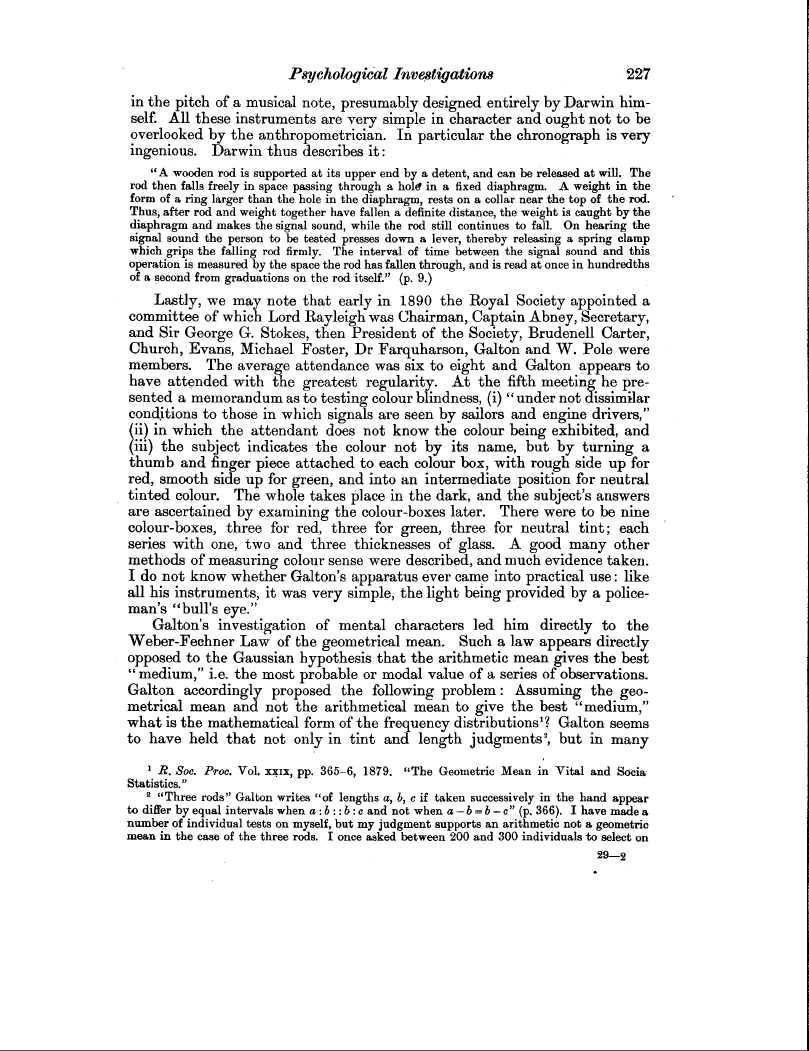Psychological Investigations 227
in the pitch of a musical note, presumably designed entirely by Darwin himself. All these instruments are very simple in character and ought not to be overlooked by the anthropometrician. In particular the chronograph is very ingenious. Darwin thus describes it
"A wooden rod is supported at its upper end by a detent, and can be released at will. The rod then falls freely in space passing through a hold in a fixed diaphragm. A weight in the form of a ring larger than the hole in the diaphragm, rests on a collar near the top of the rod.
Thus, after rod and weight together have fallen a definite distance, the weight is caught by the diaphragm and makes the signal sound, while the rod still continues to fall. On hearing the signal sound the person to be tested presses down a lever, thereby releasing a spring clamp which grips the falling rod firmly. The interval of time between the signal sound and this operation is measured by the space the rod has fallen through, and is read at once in hundredths
of a second from graduations on the rod itself." (p. 9.)
Lastly, we may note that early in 1890 the Royal Society appointed a committee of which Lord Rayleigh was Chairman, Captain Abney, Secretary, and Sir George G. Stokes, then President of the Society, Brudenell Carter, Church, Evans, Michael Foster, Dr Farquharson, Galton and W. Pole were members. The average attendance was six to eight and Galton appears to have attended with the greatest regularity. At the fifth meeting he presented a memorandum as to testing colour blindness, (i) "under not dissimilar conditions to those in which signals are seen by sailors and engine drivers," (ii) in which the attendant does not know the colour being exhibited, and (iii) the subject indicates the colour not by its name, but by turning a thumb and finger piece attached to each colour box, with rough side up for red, smooth side up for green, and into an intermediate position for neutral tinted colour. The whole takes place in the dark, and the subject's answers are ascertained by examining the colour-boxes later. There were to be nine colour-boxes, three for red, three for green, three for neutral tint; each series with one, two and three thicknesses of glass. A good many other methods of measuring colour sense were described, and much evidence taken. I do not know whether Galton's apparatus ever came into practical use : like all his instruments, it was very simple, the light being provided by a policeman's "bull's eye."
Galton's investigation of mental characters led him directly to the Weber-Fechner Law of the geometrical mean. Such a law appears directly opposed to the Gaussian hypothesis that the arithmetic mean gives the best "medium," i.e. the most probable or modal value of a series of observations. Galton accordingly proposed the following problem : Assuming the geometrical mean and not the arithmetical mean to give the best "medium," what is the mathematical form of the frequency distributions'? Galton seems to have held that not only in tint and length judgments', but in many
1 R. Soc. Proc. Vol. xxix, pp. 365-6, 1879. "The Geometric Mean in Vital and Socia Statistics."
2 "Three rods" Galton writes "of lengths a, b, c if taken successively in the hand appear to differ by equal intervals when a : b :: b : c and not when a - b = b - c" (p. 366). I have made a number of individual tests on myself, but my judgment supports an arithmetic not a geometric
mean in the case of the three rods. I once asked between 200 and 300 individuals to select on
29-2

